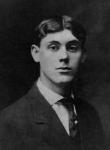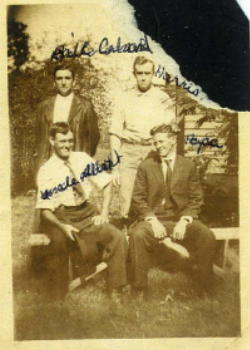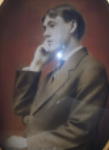
Albert c 1911 wearing
the stickpin given to him by Frances
for Christmas 1910
|
Albert,
Life before marriage
Albert Taylor Rymer was born on June 15th, 1886 in
Polk county, Tennessee and died on February 1st,
1931 in Murray county, Georgia. According to "Aunt
Lou"; (Mary Louise Rymer Miles) his sister who was
some 16 years older, his birthplace was at the
foot of the hill along the Ocoee River just back
of Ocoee dam. Today the top of this hill appears
as a small island in the lake.
Not much is known of his early days, I assume
he was much like other country boys. He probably
worked with his father "Black John" in the
blacksmith shop , doing what was necessary,
together with the rest of his family, to provide
food,clothing and shelter. Albert's father died
in 1901 when he was 15, making him the "head of
the household" as his older brothers ranged in
age from 23 to 42 and as far as we can
ascertain, did not live at home.
At the time "Black John" died the Parksville
dam was being planned, the farms of "Black
John" and his son Will (among others)
would be covered by water, the families had to
move. Will and his family moved to the
Cookseon's Creek community in 1904 and lived
there until 1910. Based on a letter to his
mother written in 1910Albert appeared to have
been living with his brother Will. It is
possible (but not known) that Albert and his
mother lived with them during this period. A
link to this letter can be found later on this
page.
|

Front Row:
Albert and his brother Wilford (Will)
Back Row: Bill Colvard and ? Harris.
Date unknown
|
Albert's oldest brother's (Tom), wife had a baby,
the wife (Jennie Norman Rymer) died during
childbirth. Albert's mother was a widow and she
moved to Tom's home to raise the child, a girl
named Jennie. Tom later married Susie Williamson
and lived on a farm across the road from the "Old
McCamy Farm" where Harry and Kathy Rymer live in
2010.
Some, if not much of the family food came from
hunting and, to some extent, fishing. Albert and
his brothers shared his love of hunting and
fishing throughout their life. His education was
what was available in the area at the time,
according to his daughter Elizabeth it was
probably about like a 4th grade education today.
Parksville dam, or Ocoee # 1, was constructed
in early 1900's. A railroad was built from the
Louisville and Nashville railroad (Now CSX) to
the dam site to bring in material. After the dam
was completed and lake filled, material was
brought to the dam by railroad, then hauled over
the dam, placed on a supply boat and ferried to
build the "Flume Line". The "Flume Line" was a
box some 11 feet high by 14 feet wide, water in
the river was directed into the box, which had a
very slight downstream slope of about 16 feet,
from a small dam for some five miles to the
Ocoee # 2 powerhouse. At this point the box
which started at river level is now over 200
feet above the river bed, dropping through 2
pipes to make hydroelectric power. Needless to
say, this required a considerable number of men
to build. A good source (even with several
errors) for more information on the Ocoee river,
building the dam and Flume Line is: The
Ocoee river and its dams (Any copyright
info on this site belongs to its owners)
From the early 1800's until the Parksville dam
was built and the lake filled there was a road
along the Ocoee river from Copperhill to
Cleveland where, in early days the copper was
hauled by wagon from Copperhill to the railroad
at Cleveland. This was known as "The Old Copper
road". Building the dam and filling the lake
covered the road, cutting off the direct route
from Copperhill to Ocoee and Cleveland. The road
around the lake was not completed until the
1930's, some 25 years later.
The
day after Christmas in 1910, Albert wrote his
mother who was in Arizona helping her sick
daughter. In this letter he mentions he is
dating Frances and the letter indicates this is
the first time his mother had heard about her.
to see a copy of this letter Click Here.
In 1912, Albert was working as a member of a
carpenter crew building the "Flume Line". He was
also finding time to "court" Frances who lived
in the house where Harry Rymer lives today
(2009). You may think this took little effort,
it is probably 15 or 20 minutes today on US 64,
from where he worked to Frances's home. In 1911
and 12, it was probably at least 4 hours each
way.
In 1910-12, there were few cars in Polk county.
Here are the options we believe were available
to Albert if he wanted to see Frances:
- Ride the supply boat from the top of the
lake to the Parksville dam, walk to his family
home, next day walk to see Frances. Do the
reverse on Sunday to get back. (Assuming the
supply boat carried workers out and back on
weekends this is the best option)
- It is highly likely workers and other who
lived in the mountains made a trail following
the lake shoreline. Using this trail around
the lake is the best option if the supply boat
was not available.
- By road you could come down the Old Copper
road from the Flume Line to the head of the
lake at Greasy Creek, go up the road to
Reliance and follow the Hiwassee river down to
the road from Knoxville to Atlanta. Go south
on the road to Benton and then to Ocoee.
Adding about 20 miles to the travel distance.
This was a rough, dirt road until after WW II.
Based on the options, a guy really wanted to
see a girl to make the trip frequently. We do
know Albert made the trip frequently enough to
show interest and love, when he asked Frances,
the pretty young teacher, to marry him she said
"Yes".
Back



